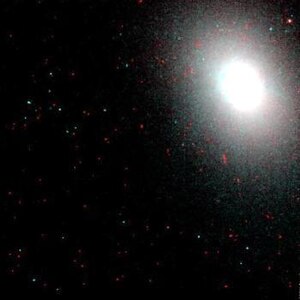NGC 5077
| Galaxy NGC 5077 |
|
|---|---|

|
|
| AladinLite | |
| Constellation | Virgin |
|
Position equinox : J2000.0 , epoch : J2000.0 |
|
| Right ascension | 13 h 19 m 31.6 s |
| declination | -12 ° 39 ′ 25 ″ |
| Appearance | |
| Morphological type | E3-4 / LINER / Sy1.9 |
| Brightness (visual) | 11.4 mag |
| Brightness (B-band) | 12.4 mag |
| Angular expansion | 2.2 ′ × 1.6 ′ |
| Position angle | 7 ° |
| Surface brightness | 12.8 mag / arcmin² |
| Physical data | |
| Affiliation | LGG 343 |
| Redshift | 0.009360 ± 0.000070 |
| Radial velocity | 2806 ± 21 km / s |
|
Stroke distance v rad / H 0 |
(121 ± 8) · 10 6 ly (37.1 ± 2.6) Mpc |
| history | |
| discovery | Wilhelm Herschel |
| Discovery date | May 11, 1784 |
| Catalog names | |
| NGC 5077 • UGCA 347 • PGC 46456 • MCG -02-34-027 • GC 3486 • H II 193 • h 1577 • 3490 • LDCE 955 NED036 • HOLM 514B | |
NGC 5077 is an 11.4 mag bright elliptical galaxy with an active nucleus of the Hubble type E3 in the constellation Virgo on the ecliptic . It is estimated to be 121 million light years from the Milky Way and about 80,000 light years in diameter. Together with NGC 5076 and NGC 5079 , it forms the galaxy trio Holm 514 .
The object was discovered on May 11, 1784 by Wilhelm Herschel , together with NGC 5076 and NGC 5079 , with an 18.7-inch reflector telescope.
NGC 5077 group ( LGG 343 )
| Galaxy | Alternative name | Distance / million Lj |
|---|---|---|
| NGC 5077 | PGC 46456 | 121 |
| NGC 5079 | PGC 46473 | 96 |
| NGC 5105 | PGC 46664 | 125 |
Web links
- NGC 5077. SIMBAD , accessed May 26, 2015 .
- NGC 5077. DSO Browser, accessed May 26, 2015 .
- Auke Slotegraaf : NGC 5077. Deep Sky Observer's Companion, accessed on May 26, 2015 .
